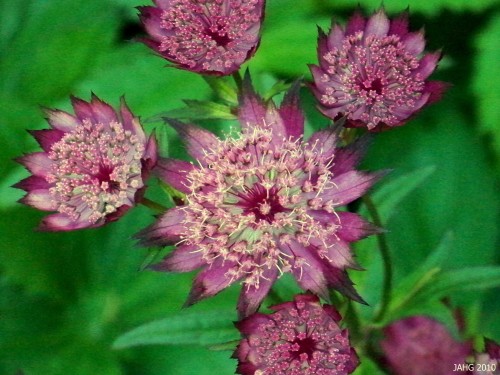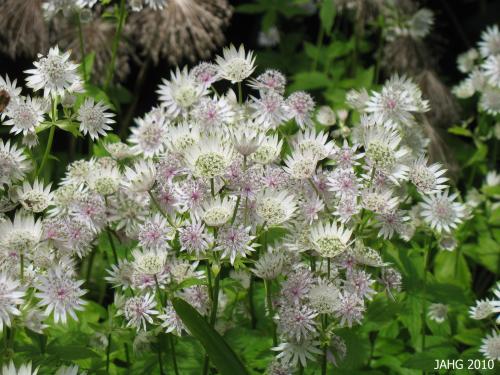There are many plants that seem almost mythical when you grow up in a very cold climate. Some plants are spices you want to grow like Ginger while others have fantastic forms or leaves like Caladiums and some have intense or unusual colors like sky blue flowers. One plant which definately seemed to be a unreal to me were the big blue Bigleaf Hydrangeas (Hydrangea macrophylla) which I saw in florist shops or as dried flowers. Now I know they are real!

Late June and throughout summer Hydrangea 'Endless Summer' colors many shrub and perennial borders here.
Hydrangea macrophllya or Bigleaf Hydrangea orignates from Japan and was introduced to us by German naturalist Philipp Franz Balthasar von Siebold(1796-1866). he was the first European teach western style medicine in Japan from 1823-1829. He was able to after treating and healing in influential officer he was able to leave the isolated island near Nagasaki( Deshima) where outsiders were forced to live. While he was able to spend time off the island and started a medical school with 50 pupils and they helped him study the plants and animals which were only found in Japan which was his main interest there. During his short time in Japan he traveled to Edo(Tokyo) to collect specimens and later started a botanical garden behind his home with a greenhouse with over 1000 species of plants found in Japan.
The Japanese believe that Bigleaf Hydrangeas was introduced into China from Japan. This may be true as Hydrangea macrophylla (f. normalis) is found growing on Honshu island in and around Tokyo and the island there. Hydrangea serrata is now held to be a form of macrophylla and also comes from mountainous areas of Japan and Korea. the Japanese have cultivated and breed flower colors and forms for hundreds of years.
Hydrangea macrophylla is interesting in that there is a great range of color from deep blue through almost red and many shades in between in the violets. shades also run to white. Color in Bigleaf Hydrangea can be very much influenced by the acidity of the soil. It is not unusual to see a recently planted shrub have slightly different coloring in the following years. If color is important to you first decide if you want pink or blue, if pink is wanted add a little dolomitic lime a few times a year to make the soil less acidic if you need to. For blue flowers you need to add aluminum sulfate at the rate of 14 ml or 1/2 oz (1 Tbsp) aluminum sulfate per gallon of water applied to the plant. the ph of the soil should be 5.2-5.5 constantly for a good blue.

A cacophony of reds and violets in a Hydrangea macrophylla border planting at Government House In Victoria.
Hydrangea macrophylla is very common here and there are many very old plants found in the older areas of this part of the island. They are remarkably adaptable plants which tolerant a range of conditions. Bigleaf Hydrangea tolerate complete shade to full sun but like it best when they get morning sun and protection from the afternoon heat. They need a rich moisture retaining soil which is nutrient rich to grow their best. They can grow in clays soil which are common here as along as they are not in a posistion of being kept too wet all the time, the more sun exposure and heat – the more water they will naturally need.
A question often asked about Bigleaf Hydrangeas is how and when to prune. Hydrangeas need little pruning, removing spent flowers after blooming and shaping and thinning are both done soon after flowering as they set their flower buds for the next year soon after this. When pruning have a light touch and remove individual stems which are weak or congesting the plant, this way you will retain most of your flowers for the next year. the only time you might have to do major pruning is after a very cold winter where the tips have been damaged or killed.

Here the slightly gaunt spent Hydrangea macrophylla flowers are left for winter interest in the gardens at Government House.
Hydrangea macrophylla tolerate zone 8(-12c or 10f) which means mild winters such as here in the northwest of North America. They range in size between .6-2m (2 to 6ft) although I have seen some which are closer to 3m(9ft), care should be taken in finding one that fits in the space you have. Types which are listed(incorrectly) as ‘serrata’ species often are shorter in stature and are very well suited for our smaller urban gardens.

The black coloring in this Hydrangea macrophylla. var.serrata 'Preziosa' adds some drama to the garden.
The best place to see Hydrangea macrophylla cultivars is at Governement House, Walk the long borders and you will find sections in the shade and full sun. As you go to the back past the winter garden (leading to the Terraces) you will come to another section with violet and reds, these fade to the most interesting slate colors later with a touch of navy in them. Finnerty Gardens also have a good selection of species Hydrangeas which are found behind the chapel edging the grass area.
for Your Hydrangea Hunting Pleasure:
A short description of Hydrangeas in Japanese culture, art and history: http://blog.alientimes.org/2010/06/a-gathering-of-blues-hydrangrea-ajisai-in-japanese-culture-and-history-revisited/
An extensive listing of many of the cultivars avaialbe today and experiences of people growing them: http://davesgarden.com/guides/pf/b/Hydrangeaceae/Hydrangea/macrophylla/cultivar/0/
Philipp Franz Balthasar von Siebold who brought us so many Japanese plants before anyone else: http://en.wikipedia.org/wiki/Philipp_Franz_von_Siebold
A great site about Hydrangeas with pages on coloring, pruning and care for the plants: http://www.hydrangeashydrangeas.com/index.html
Soon we will meet again here….I hope!























 Stumble It!
Stumble It!






